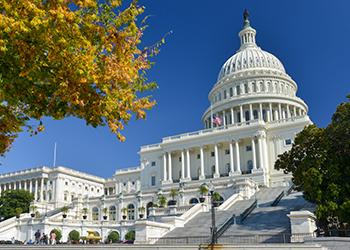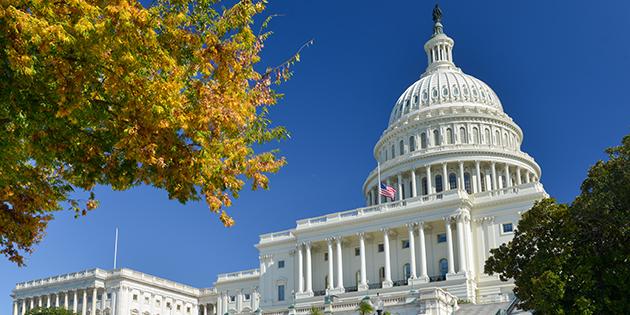
Orhan Cam/Shutterstock
With every new administration, there are changes in higher education policy. Understanding higher education policy at the federal level is crucial for universities looking to predict how new legislation may impact their faculty, staff, and students. In this month’s interview Lauren Maddox, senior policy advisor at Holland & Knight, discusses her work on governmental higher education policy, recent policy developments, and advice for higher ed professionals moving forward.
Andrew Hibel, HigherEdJobs: Ms. Maddox, you are not our typical guest in terms of working at a college or university. Would you please explain a little about your background and how it led to your position working with governmental higher education policy?
Lauren Maddox, Senior Policy Advisor, Holland & Knight: Having worked on Capitol Hill, at the Department of Education during the Bush [#43] Administration, and as an advocate and strategist for causes and concerns of those I represent, I have been involved in the framing and shaping of public policy for many years. In particular, during my time at the Education Department, then Secretary Margaret Spellings unveiled the findings and recommendations of the Commission on the Future of Higher Education. The “Spellings Commission” addressed growing concerns about affordability and accessibility. As well, my time at the agency overlapped with the collapse of the capital markets, creating urgency around the development of policy solutions to ensure students had funds to cover their college costs. These and other issues are still relevant today. As the Congress looks to reauthorize the Higher Education Act (HEA), which has been eligible for several years now, I look forward to engaging in the conversation to ensure students have the funding, support, and information they need to make the right decisions about their educational pursuits.
Hibel: How is higher education policy created at the legislative and administrative levels?
Maddox: Higher education policy is — and should be — developed with the input of all stakeholders, including the students who are furthering their education and the institutions providing the knowledge and skills. It is critical for those in decision-making roles — our elected officials and other public servants — to understand the issues. The way they do that is to listen, learn, discuss and deliberate with concerned parties across the political spectrum. There is any number of possible solutions, but the key is to understand the impact and consequences of potential ideas such that the right decisions are made to the benefit of the neediest students.
Hibel: What major changes has the Department of Education made over the past 18 months in regards to higher education policy?
Maddox: One area of focus in higher education has been deregulation. This effort was launched in a bipartisan way several years ago when a group of Democratic and Republican senators, including Senate Health, Education, Labor and Pensions (HELP) Committee Chairman Lamar Alexander (R-TN) and Sen. Michael Bennet (D-CO), a former school superintendent and influential member of the HELP Committee, launched a comprehensive effort to identify and make recommendations to reduce the regulatory burden imposed on post-secondary institutions. In keeping with that robust congressional initiative and the current administration’s push to review and eliminate regulations that are duplicative, outdated, and/or burdensome, the Department of Education is working to fulfill that goal. Additionally, there has been a deliberate shift away from addressing policy concerns through guidance letters and the like; the current administration is more inclined to use negotiated rule-making to bring parties together and air concerns and ideas in a public forum. In recent months, the Department held negotiated rule-making on the gainful employment and borrower defense to repayment regulations and more “neg reg” sessions are expected. There is also an effort to reform the office of Federal Student Aid (FSA), improve its systems and offerings, and streamline operations to support a better “student experience.” Finally, the Department has been — and will continue to — provide technical assistance (TA) to policymakers engaged in updating HEA to be more responsive to students’ needs, including those of life-long learners who are looking for flexible hours, online options, and credit for experience and expertise gained in the workplace.
Hibel: Under previous administrations, accessibility to higher education was a strong focus of their policy efforts. What is the current administration’s view on accessibility?
Maddox: Accessibility remains a focus. As well, affordability and accountability. There is an effort underway to remove those regulations and mandates that are overly burdensome, costly, and/ or duplicative for institutions of higher education. Also, there is growing interest in having institutions bear more responsibility for the success of their graduates. This notion of colleges and universities having “skin in the game” is gaining steam — both at the policy and institution level. What this means in terms of legislation and regulations has yet to be determined, but it is a constant theme and one that policymakers on both sides of the aisle are prioritizing.
Hibel: As there has been more uncertainty in higher education policy and regulations, how has innovation been affected by the times of unpredictability?
Maddox: Innovation is critical and a goal — whether on the Hill as reflected in provisions included in the Carl D. Perkins Career and Technical Education (CTE) Act update, which passed the House with an overwhelmingly bipartisan vote last year and is awaiting Senate action, or in policies and programs promoted by the administration. There is broad recognition that much has happened in higher education since 2008, when Congress last reauthorized this important legislation, and should be addressed through new policies developed with thoughtful deliberation and across the aisle. For example, competency-based education (CBE). CBE is just one example where innovation is well ahead of the policy and regulation governing the space. Members of both parties — most of whom have a college(s) in their district or state — are interested in hearing concerns of students and families, institutions of higher education, and of local employers, and addressing them in ways that accommodate all. As well, there is hope that, as has happened in every other industry, technology will bring down costs and provide curriculum and content to more students of all ages in need of knowledge and skills development.
Hibel: If you had the ability to look forward into a crystal ball, what policy changes would you expect in the next five years?
Maddox: There is considerable interest among policymakers to address accreditation and place more emphasis on outcomes than input; reform and simplify the student loan system to ensure it’s a help, not a hindrance to those who seek to further their education at a post-secondary institution; and, update and streamline data systems such that the information collected is worthwhile, integrated, analyzed, and shared in more user-friendly ways.
Hibel: If you were providing advice to a higher education professional looking to start a career in academia, what two pieces of advice would you give them in order for them to be prepared to succeed?
Maddox: First, thank you for your service! Teaching is a calling and I’m grateful for your willingness to answer the call, inspire today’s students, and educate tomorrow’s leaders. Please engage in public policy discussions. Your wisdom and guidance are critical. Too often, policy decisions are made in Washington that sound reasonable and meritorious, but are simply not practical from an operational perspective. If those engaged in the delivery of knowledge and skills are also in touch with elected officials who are making decisions about policy and regulation, the end product will be better and sustainable. If policy and regulatory decisions are made in a vacuum and without the benefit of those tasked with implementation, there is likely to be resistance at every step in the process.
Second, keep an eye on what content is relevant and applicable. Students — and their families — are spending considerable amounts of money to obtain a degree and, as such, are questioning the return on investment. Bottom line: they’re scared their investment of time and resources will not lead to a fulfilling job in their field of study. They want to know — in fact, are demanding to know — that courses in which they are enrolled will be relevant to their work post-graduation. Make sure to connect the dots for them.
Hibel: What keeps you engaged in working with colleges and universities on higher education policies?
Maddox: My belief in the value of education, including post-secondary experiences, to fulfill one’s career goals, expand one’s knowledge of the world, and broaden one’s perspective. My parents placed significant value on education and travel — two things that once you have and experience, no one can take away from you. The challenges colleges and universities are wrestling with today, including reaching more people of all ages who are looking to enhance their knowledge and skills and inspiring thoughtful debate on any number of urgent matters, are significant. Add technology and capacity concerns to the mix and the policy solutions needed multiply. There is much to do and many issues on which to be engaged.
